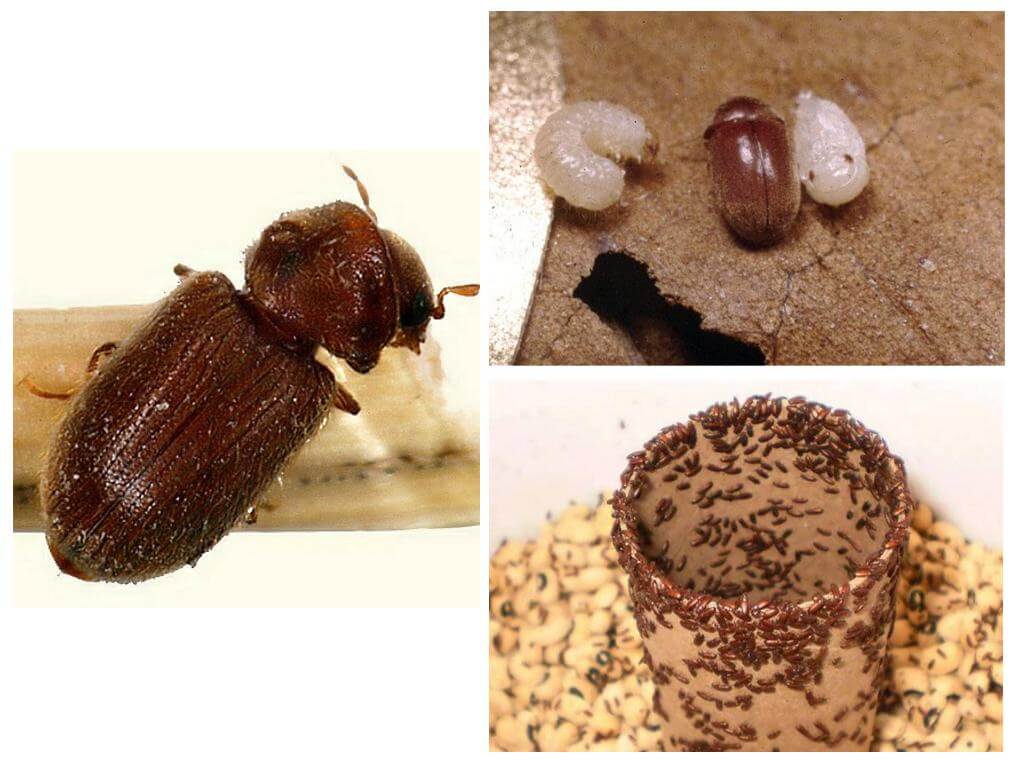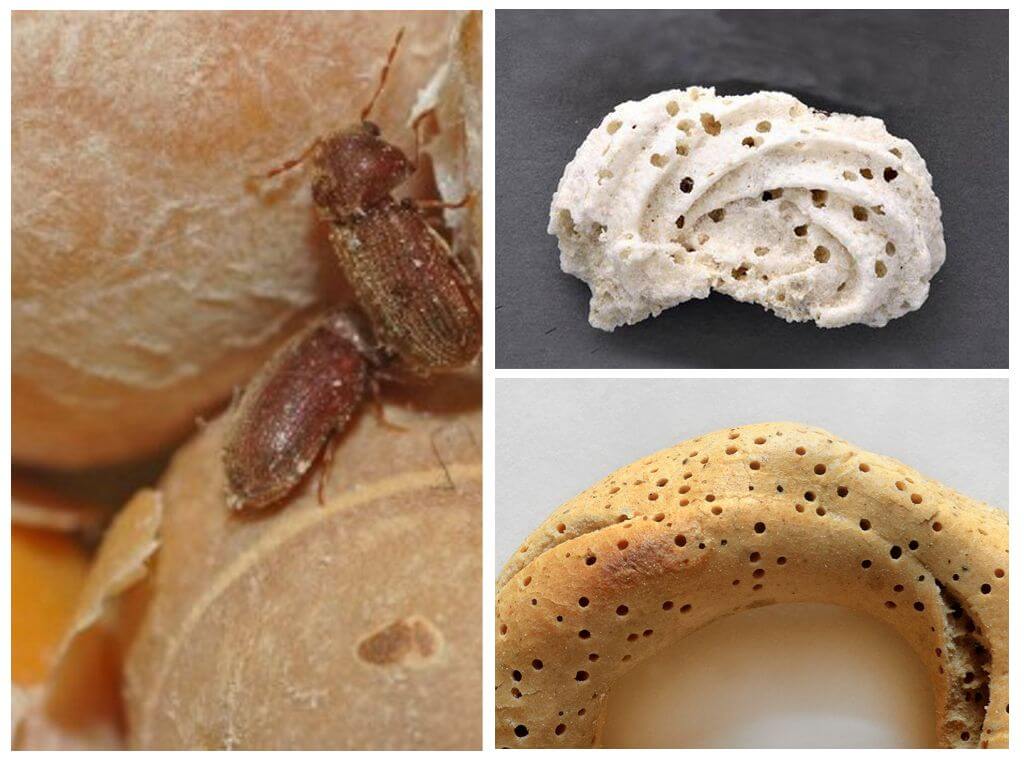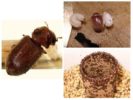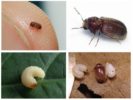- Bread grinder
- Grain Grinder Larvae
- Bread grinder
Bread grinder - a nondescript bug that can cause devastating damage to food supplies. The insect eats flour, cereals, crackers, biscuits, animal feed, medicinal herbs, as well as books, herbaria, biological collections. With a slight infection for a long time, the presence of a bread grinder goes unnoticed. When there are too many bugs, they begin to creep around the house in search of a new food base. Detailed instructions for recognizing insects and how to deal with them will help you quickly get rid of pests.
What does a bread grinder look like?
The bread grinder has a small body size and a brown color, shades can be from light brown to dark brown. The length of the adult is from 1.5 cm to 4 cm. The back is cylindrical in shape and, like a hood, is pulled over the head. The whole body is covered with thick yellowish villi.
Interesting!
Insects have developed wings and are able to fly. Flight abilities are shown mainly at night. Sensing danger, the bread grinder demonstrates the miracles of disguise and pretends to be dead.

Adult beetles do not eat anything. They make up for their energy needs from the reserves accumulated during the growing period. The harm of adults lies in the spoilage of products in which they make through holes. Grinders are temperature resistant. The optimum temperature regime for them is + 25-30 ° С, at a temperature of +4 ° С the larvae retain their viability. Therefore, the conditions in the apartments for beetles are the most favorable.
Features breeding grinders
The female lays between 60 and 80 whitish eggs in the nutrient substrate. After 1-2 weeks, they turn into fleshy, off-white larvae with developed teeth that allow them to gnaw even the hardest materials. Young voracious individuals do not differ in legibility in food and eat the product in which they find themselves. Larvae of the bread grinder gnaw tunnels, leaving behind excrement. In the package, where the pest has been, everything is covered with trash and traces of life. Pay attention to what the bread grinder looks like in the photo, its offspring and products damaged by pests.
The development of young animals depends on the ambient temperature and lasts from 30 to 100 days. During this time, the larva undergoes several molts. For pupation, a mature caterpillar constructs a cocoon for itself from food microparticles, gnaws a cradle in solid substrates. After 15-20 days, a young beetle appears from the cocoon. To get out, he gnaws at himself a flying hole. Adult bread grinders live about 30 days.

Interesting!
The adult, after pupation, has an impressive abdomen, in which fat reserves are concentrated, which ensure the vital activity of the insect. Over the course of life, it noticeably decreases in size.
Where are the bread grinders hidden?
A bread grinder absorbs literally everything that falls into its field of vision.The only thing he does not touch in the apartment is wood and building materials. The priority of the insect food:
- bread, crackers, cookies, waffles;
- pasta from all types of wheat;
- cereals;
- sugar, confectionery;
- dried fruits;
- Tea coffee;
- pet food;
- medicinal herbs, including poisonous ones.
In addition to provisions, a bread grinder can be flattered by herbariums, bouquets of dried flowers, books, stuffed animals, and tobacco products. It is possible to determine that pests are wound up in the home library by the presence of abundant paper dust. Larvae gnaw at passages in books, they eat some of the paper, some simply grind into dust. Grinders can live anywhere in an apartment. An old bundle of newspapers and magazines, a forgotten paper souvenir, a reverently kept wedding bouquet - all this can become a habitat for pests, which for a long time will not give out their presence.
Important!
Bread grinders crawling along walls, window sills, on the floor are a clear sign of severe infection. This means that there are too many of them divorced and they are looking for a suitable nutrient substrate.
Insects get into the apartment in 2 ways:
- Penetrate through the windows, window slots.
- Brought along with purchases, most often infected are cereals, dried fruits. If the purchased products have not been poured into airtight containers, grinders multiply, gnaw holes in a plastic bag and infect another product.
How to get rid of pests in the kitchen

Bugs are much easier to breed than annoying ubiquitous cockroaches or ants. Before you get rid of a bread grinder in the kitchen, you should understand that this insect does not hide in secluded places and does not go hunting after nightfall. The grinder lives and reproduces directly in the substrate, mainly in food. It is enough to find the source of infection and dispose of it.
Important!
Food contaminated with a bread grinder should never be consumed! They are filled with waste products of the insect, which can provoke an eating disorder, poisoning.
The action plan for getting rid of pests is reduced to the audit of all kitchen utensils. It is necessary to scrupulously check the contents of all jars, boxes. You can not ignore the decorative ornaments made from natural materials on the cabinets.
Feedback
One night, I saw a wandering little bug on the table. It became curious what kind of creation it was and began to search for information on sites about domestic pests. Having compared her copy and photo, she was surprised to learn that this is a bread grinder. I checked all the cereals, dried fruits, but found nothing suspicious. And only during the general cleaning of the kitchen I found a decorative broom-charm on the upper cabinet. The cellophane with which it was packaged resembled a sieve, and the broom itself turned into fine dust with decorously crawling fat white caterpillars.
Victoria, Volgograd
The success of the fight against grinders is determined by the thoroughness of the search for spoiled products. If it was possible to detect a cluster of beetles in one place, this does not mean that they are no longer anywhere and they were completely eliminated. All provisions need inspection. Detected infected products must be disposed of, and beetles are destroyed by mechanical action, that is, crushing. After completing the search and liquidation work in the kitchen, the inner surfaces of the cabinets should be washed and treated with a solution of vinegar, soda. Soak jars in which contaminated products were soaked in soapy water and washed. It is irrational to get rid of bread grinders with the help of insecticides.
If you suspect that the products are infected, but there are no obvious signs, the following measures are taken:
- cereals are sifted and warmed up in the oven;
- infected products must be placed in the freezer for 12 hours, and then fry in a pan for 15-20 minutes;
- Beans and peas pour cold water, in case of infection, the larvae will float to the surface.






